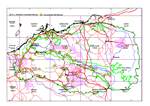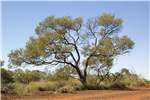Click on images
to enlarge



Photographer: B.R. Maslin

Photographer: B.R. Maslin

Photographer: B.R. Maslin
 6, Mt Florance Stn, BRM photo, 16 Oct 2004, ADJUSTED RICHARD WOODMAN_sml.jpg)
Photographer: B.R. Maslin

Photographer: M.W. McDonald
, BRM 5573, ORIGINAL SCAN, ADJUSTED RICHARD WOODMAN_sml.jpg)
Photographer: B.R. Maslin
, 13 km E of Manilya, BRM 29Aug 1988_sml.jpg)
Photographer: B.R. Maslin
, 5 km E of Little Sherlock River, BRM 17 Oct 1984_sml.jpg)
Photographer: B.R. Maslin
, BRM 8713, photo J. Maslin, ORIGINAL SCAN, ADJUSTED RICHARD WOODMAN_sml.jpg)
Photographer: J. Maslin
, BRM 8713, lab photo by Fiona McCallum ADJUSTED_sml.jpg)
Seed from one herbarium voucher. Scale in mm. Photographer: F. McCallum.
Botanical name
Acacia xiphophylla E. Pritzel, Bot. Jahrb. Syst. 35: 305 (1904)
Common name
Snakewood
Aboriginal name
Marruwa (Ngarluma, Kurrama, Banyjima, Martuthunira and Yindjibarndi), Marrawa, Mourowa, Pugardi or Pukarti (Kurrama), Puyuwarra (Putijarra), Pukarti and Murruwa (Martuthunira), Puluru (Kariyarra), Pukarti (Jiwarli), Bugardi (Thalanyji) and Murruwa or Bugardi (Banyjima)
Description
Often gnarled, moderately dense, spreading shrubs or trees (1.5-) 3-5 (-6) m tall and up to 8-12 m wide, with 2 or 3 twisted main trunks (to about 40 cm diameter near base), the wide-spreading branches often rather contorted. Bark dark grey, fibrous on main trunks, smooth or fibrous on branches. Branchlets glabrous or sparsely appressed -hairy. New shoots sericeous with dense, appressed hairs which are yellow at first but age silvery. Phyllodes narrowly elliptic to narrowly oblong-elliptic, 5-12.5 cm long, (5-) 6-13 (-16) mm wide, coriaceous, rigid, ascending to erect, straight to shallowly incurved or recurved, sericeous with minute, silvery white, closely appressed, straight hairs that often drop off as phyllodes mature, bluish grey to sub-glaucous, sometimes silvery green (?when young); parallel longitudinal nerves numerous, close together, fine and scarcely visible, the central nerve sometimes slightly more evident than the rest; the apex obtuse to acute and innocuous to coarsely pungent; pulvinus light orange. Inflorescences rudimentary 1- or 2-headed racemes with axes c. 0.2 mm long, often growing out; peduncles (5-) 7-17 mm long, ±appressed-puberulous; receptacle appressed -hairy; spikes 2.5-5.5 cm long, loosely flowered, light golden, sweet-scented. Flowers mostly 5-merous; sepals ¼-1/3 length of petals, united, often golden-hairy. Pods pendulous, broadly linear, flat but rounded over seeds, straight-edged or shallowly constricted between seeds, (6-) 8-21 cm long, mostly (7-) 9-15 (-18) mm wide, thinly crustaceous to crustaceous-coriaceous, straight to slightly curved, irregularly coarsely reticulate, glabrous (rarely hairs present), brown (often darkest over the seeds), yellowish light green just prior to maturity. Seeds longitudinal in the pods, broadly ellipsoid to almost orbicular, flattened, 6-11 mm long, not shiny, brown; aril small, dull yellow.
Characteristic features
Often gnarled, spreading shrubs or trees that are adapted to clay soils. New shoots yellow hairy at first, aging silvery. Phyllodes narrowly elliptic to narrowly oblong-elliptic, acute to acuminate, rather large (mostly 5-12.5 cm x 6-13 mm), coriaceous, rigid, generally straight, longitudinal nerves very obscure. Spikes long (2.5-5.5 cm), loosely light-golden flowered. Pods broadly linear, mostly 9-15 mm wide, obviously raised over seeds and not or scarcely constricted between them, large, thinly crustaceous to crustaceous-coriaceous, normally glabrous, shiny. Seeds large, distinctly flattened; aril small.
Distribution and ecology
Widespread and common (in suitable habitats) in northwest Western Australia. It extends from Shark Bay northeast through the Ashburton district to the Pilbara where it is most common in central and western regions, as far north as Roebourne and southeast to Roy Hill. There is an outlying population of Snakewood from near Wiluna, well south of the Pilbara. Grows on sometimes ±saline or calcareous, alluvial flats, or on stony plains or hill slopes, in clay, gilgai or texture-contrast soils. It is often common in the places where it occurs where it often forms more or less single-species stands. Best growth and development occurs in areas where there is at least 25 cm of sandy loam on the surface (Turnbull 1986). In the Fortescue valley Snakewood is associated with Mulga (Fox and Dunlop 1983) while on the Onslow Plain it grows in neutral red earths with spinifex (Triodia spp.) and Wattles such as A. tetragonophylla and A. synchronicia (Beard 1975).
Flowering and fruiting period
Flowers quickly and opportunistically in response to rain. Flowering specimens have been collected in January, March-May and August-September. Pods with mature seeds have been collected between September and December.
Affinities
Closely related to A. eremaea (which does not occur in the Pilbara) and A. intorta (see that species for discussion). Snakewood is perhaps also related to A. hamersleyensis which is most readily distinguished by its more obvious phyllode nerves (best observed at x10 magnification), denser inflorescence spikes, hairy, smaller pods and larger, more deeply divided, white-hairy calyx; see Maslin (1982) for further information concerning differences between these two species. Some old plants of A. levata may have slight Snakewood growth form, thus superficially resembling a small plant of A. xiphophylla (see A. levata for discussion and differences).
Notes
A slow-growing, long-lived plant that regenerates from seed and apparently does not produce root suckers. It does, however, have moderate coppicing ability when cut or damaged (e.g. by cool fire) at ground level; it will also reshoot from the terminal branches following cool fires. The plants are readily killed by hot, or even moderately hot, fires. The seeds are soft-coated and therefore may not require treatment prior to sowing.
The dense wood makes an excellent fuel, burning slowly and with great heat (Turnbull 1986). In the Pilbara the species is sometimes used as in craft wood on account of the attractive color differentiation between the dark heart wood and surrounding pale-coloured sap wood. The foliage is eaten by stock only as a last resort in times of severe forage shortage; plant frequency may increase following heavy grazing (Mitchell and Wilcox 1994).
Indigenous peoples of the Pilbara used A. xiphophylla in a number of ways. The wood was used to make boomerangs (wirra, birrirdi), spear throwers (mirru), fighting sticks (wanu, warlanu) or burnt to make an ash (jirnda) which was mixed with animal fat (or nowadays, oil) to make body paint or to paint artifacts. Snakewood produces an edible gum (gardangu) and its seeds were cooked and eaten. The bark and phyllodes were burnt to make burrgu, a mixture of ash and chewing tobacco which acts as a stimulant.
Conservation status
Not considered rare or endangered.
Origin of name
The botanical name is derived from the Greek words xiphos (sword) and phyllon (leaf) in allusion to the shape of the phyllodes.
References
Beard, J.S. (1975). Vegetation survey of Western Australia - Pilbara. (University of Western Australia Press: Nedlands.)
Fox, J.E.D. and Dunlop, J.N. (1983). Acacia species of the Hamersley Ranges, Pilbara Region of Western Australia. Mulga Research Centre. Occasional Report No. 3. pp. 94. (Western Australian Institute of Technology: Bentley.)
Maslin, B.R. (1982). Studies in the genus Acacia (Leguminosae: Mimosoideae) - 11. Acacia species of the Hamersley Range area, Western Australia. Nuytsia 4(1): 61-103.
Mitchell, A.A. and Wilcox, D.G. (1994). Arid shrubland plants of Western Australia. Edn. 2. pp. 478. (University of Western Australia Press in association with the Department of Agriculture: Perth.)
Turnbull, J.W. (ed.) (1986). Multipurpose Australian trees and shrubs: lesser-known species for fuelwood and agroforestry. pp. 316. (Australian Centre for International Agricultural Research: Canberra.)
